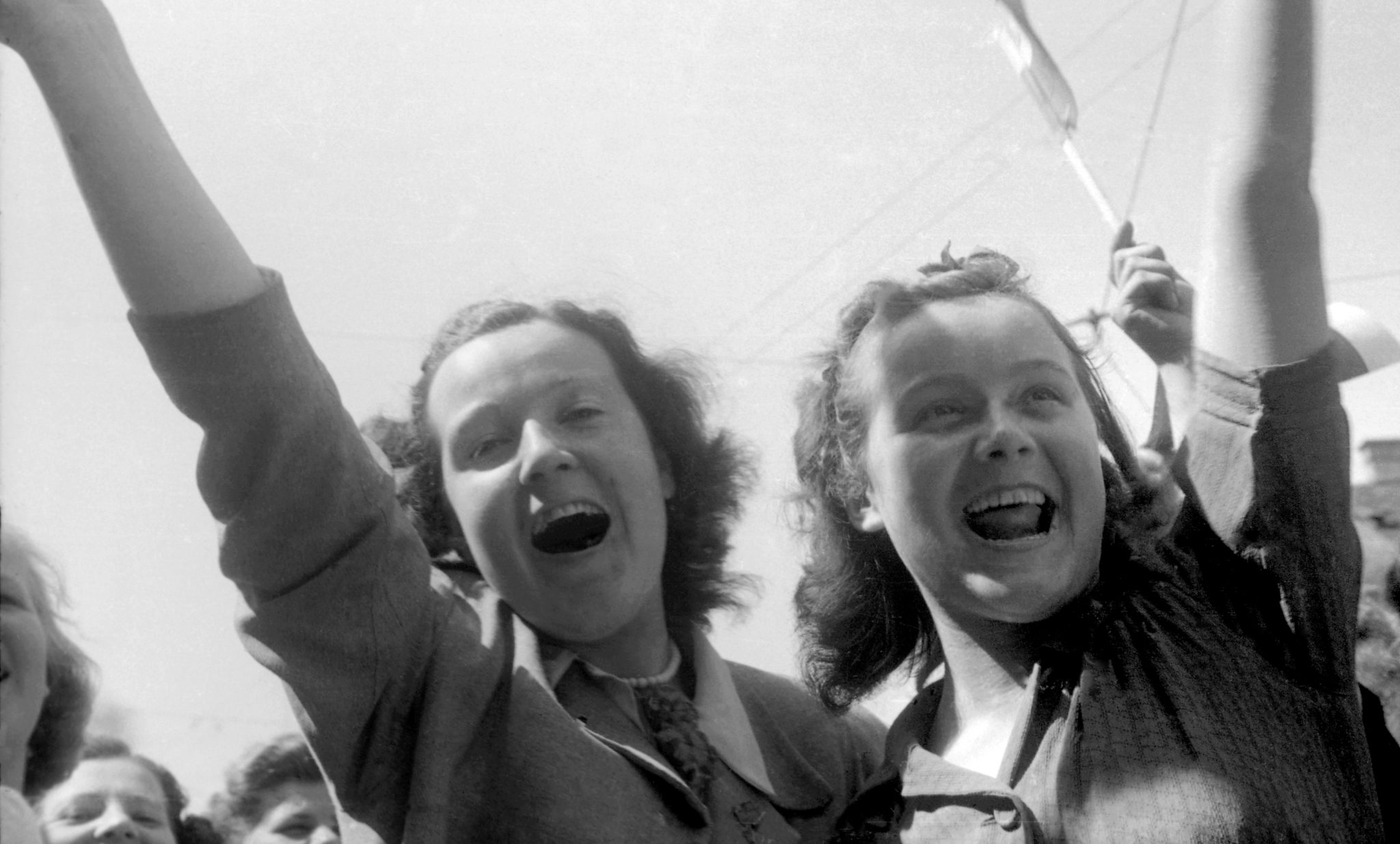Occasional photographic exhibition of the National Museum of Contemporary History of Slovenia in Gallery Božena, Photo house Pelikan, Celje
22 April 2025- 3 December 2025
Slovenski poročevalec (Slovene Reporter), the Liberation Front’s newsletter, in its issue dated May 8, 1945, published a news item entitled Unconditional Capitulation Signed! In the article, there was a message from the Allied High Command in Reins, which conveyed the news that the unconditional capitulation of Germany had been signed in the early morning hours of May 7, 1945, at 02:41 European time.
Glas kukavice (Voice of the Cuckoo), the recognizable voice of Ljubljana Radio, sounded again on May 9, 1945, along with the extremely important and long-awaited news: the German occupier had been expelled from Ljubljana. On that day, a celebratory issue of Slovenski poročevalec was also published, in which could be read exclamations and greetings to the victorious Red Army, the Yugoslav army, greetings to the Slovene Partisans and representatives of the armies of the Allied countries. Under a portrait drawing of Josip Broz Tito, Oton Zupančič wrote the poem Osvoboditeljem v pozdrav (Greetings to the Liberators). The issue informed the people of Slovenia about the events of the previous days, especially the appointment and composition of the National Government of Slovenia in Ajdovščina. The people of Ljubljana welcomed the Partisan army en masse, with flowers and enthusiasm, and celebrated the end of World War II. The end of the war was also celebrated in other Slovene cities: Bled, Kranj, Maribor, Murska Sobota. On 10 May 1945, the members of the government presented themselves to the Slovene nation from the balcony of the University. The crowd then filled Congress Square with banners almost to the last corner. In the 18th issue of Slovenski poročevalec, published on 12 May 1945, the writer Miško Kranjec wrote down his impressions of the end of the war in Beautiful Ljubljana: »And how long and how painful, how bloody was the path to this Ljubljana, which is rising today! (…) And this Ljubljana, whatever it may be, is ours again! Haven’t we really talked about it a lot, a lot, in the mountains during all these difficult four years? Haven’t we made a thousand and a thousand plans about it for the time when we return to its embrace? And now, when that long-awaited moment is here, it seems to me as if we cannot or do not dare to express all our long-held joys directly and wholeheartedly! (…) And yet, what great things have happened and are still happening, things that history will speak of forever, which will mark the passing of a milestone and the beginning of a new era!«
The Yugoslav army, in its final operations, wanted to reach all the areas it considered and claimed for its own on an ethnic basis. The Slovene government also acted in the same vein, wanting to establish civil authorities as soon as possible and organizing mass political rallies in support.
German units, which had been retreating through Yugoslavia since April 1945, were joined by various local collaborationist groups, soldiers and militias. All groups wanted to reach the territory under British control in Austria and northeastern Italy, so they moved through Slovene territory. The prevailing opinion was that, after the bitter whirlwind of war, the British would treat them more mercifully on surrender than Tito’s troops. At the end of the war, the supreme Allied authorities naturally also counted on the high probability of a massive influx of refugees who did not agree with the new Yugoslav political system. Civilian and military refugees were placed in camps, the largest of which was on Vetrinjsko Polje. On 14 May 1945, the Allied military authorities designated the area of the 5th Corps in Carinthia for return to Tito’s authority.
The photographic exhibition of the National Museum of Contemporary History of Slovenia entitled Echoes of Victory: Photographs of Crowds at the End of World War II, created in collaboration with the Slovene Ethnographic Museum and the Archdiocesan Archives of Ljubljana, sheds light on the last days of World War II and the echoes of victory in May 1945 on Slovene ethnic territory. Franc Cerar, Karol Holynski, Jože Kološa, Marjan Pfeifer, Slavko Smolej, Rudi Stopar, Edi Šelhaus, Nande Vidmar, Rudi Vavpotič were photographers who accompanied the end of the war and whose photographs are mostly kept in the museum’s Foto Slovenija collection. The motifs depicting the arrival of the Partisan army in various cities show an exceptional mass presence. Mass participation was achieved at numerous rallies that took place day after day in May 1945. The fallen fighters of the Partisan army experienced a dignified and mass farewell with a mourning ceremony in the Cathedral in Ljubljana and a funeral in Žale. The end of the war was greeted by the majority of the population with expressions of joy, happiness and hope for a better future, with great confidence in the new political authorities, which was expressed in countless textual and pictorial banners at post-war events. After the mass withdrawal of various military units after the end of the war, piles of discarded weapons and equipment remained on Slovene territory. The last motif in the exhibition is a photograph of a large number of rifles that remained without an owner. The motif thus symbolically concludes the photographic narrative of a difficult, multi-year period for the Slovene nation, which caused much suffering and many emotional wounds.
The author of the exhibition is Katarina Jurjavčič, curator of the National Museum of Contemporary History of Slovenia.
